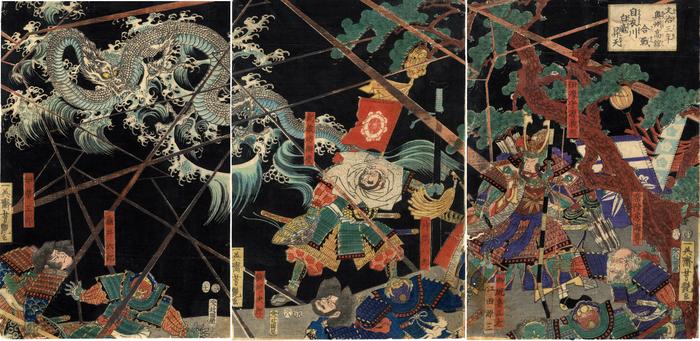Utagawa Yoshitsuya (歌川芳艶) (artist 1822 – 1866)
At the Battle of Takadachi in Ōshū Province in 1187, a White Dragon Ascends to Heaven from the Koromo River (Bunji sannen Ōshū Takadachi kassen Koromogawa yori hakuryū ten e noboru - 文治三年奥州高館合戦自衣川白竜昇天)
11/1857
9.5 in x 14 in (Overall dimensions) woodblock print
Signed: Ichieisai Yoshitsuya ga
一英斎芳艶画
Publisher: Tsujiokaya Bunsuke
(Marks 548 - seal 21-228)
Censor's seal: aratame
Date seal: 11/1857
Museum of Fine Arts, Boston
Shizuoka Prefectural Central Library
The National Museum of Asian Art
Lyon Collection - Kamei Rokurō slaying a black bear in a Kuniyoshi triptych
Ashmolean Museum
Syracuse University "A band of warriors, each identified by name in a red label, gazes in awe at a white dragon rising from the Koromo River in the midst of a lightning storm. At the center stands the great warrior-monk Benkei, who holds a staff with a red banner embellished with the Wheel of the Buddhist Law. Benkei was the devoted retainer of the young Minamoto no Yoshitsune (1159-89), who stands to Benkei's left beside a pine tree. The two tragic heroes, who died in battle in 1189, became the subjects of many legends, which were collected in the fifteenth-century Gikeiki and performed in nō and kabuki theater.
According to the elaborate legends developed around the story of Yoshitsune after his death, the Koromo River in present-day Iwate Prefecture was the site of his residence after his flight in 1187 to the northern region of Ōshū to seek the protection of Fujiwara no Hidehira. Yoshitsune had been instrumental in the Minamoto family's victory against the rival Taira during the intense political and military struggles of the Gempei (Taira-Minamoto) War of 1180-85, but in its aftermath he attracted the wrath of his elder half-brother Minamoto no Yoritomo (1147-99). After fleeing to the north, Yoshitsune established a stronghold at the Koromo River, where he ultimately was forced to kill his wife, his daughter, and himself in 1189.
In this triptych, Yoshitsuya, a pupil of Kuniyoshi reveals his mastery of conventions of the warrior subjects popularized by his teacher's bold, innovative designs. The flat, black background focuses attention on the white dragon and the brilliant armor of the warriors in the foreground. In comparison with Kuniyoshi's prints, which are full of action, the figures in this print seem to have stopped momentarily, as if they were actors in a kabuki performance."
Quoted from: Masterful Illusions: Japanese Prints in the Anne van Biema Collection, pp. 246-47.
There was a medieval ballad drama called Takadachi which was adapted to the early 17th century puppet theater in five acts.
****
Illustrated in:
1) color in Japanese Warrior Prints 1646-1905 by James King and Yuriko Iwakiri, Hotei Publishing, 2007, page 364. The story of the white dragon was first recorded in 1717 in the Kamakura jikki (鎌倉実記) by Katō Kensai (加藤謙斎: 1669-1724).
2) in black and white in Ukiyo-e Masterpieces in European Collections: Museum für Ostasiatische Kunst, Berlin, supervised by Muneshige Narazaki, Kodansha, 1988, #140, p. 188. They refer to their copy as The White Dragon Rising During the Battle of Takadate in Michinoku District.
3) color reproduction in Masterful Illusions: Japanese Prints in the Anne van Biema Collection, University of Washington Press, 2002, pp. 246-247, #95.
4) color - the center and right panels only in Die Macht des Bogens: Japanische Bogenschützen im Spiegel alter Holzschnitte by Johannes Haubner, Verlag Angelika Hörnig, 2014, pp. 96-97.
****
There is also another copy at the McMaster Museum of Art in Hamilton, Ontario.
Kamei Rokurō appears in two spectacular triptychs in the Lyon Collection
Kamei Rokurō (亀井六郎) died at the Battle of Takadachi. He appears, seen from the back, in the bottom center in the left-hand panel in this triptych. He is looking up into the sky at the lightning and dramatic white dragon. He also plays a prominent role in the killing of a black bear in the right-hand panel of another Kuniyoshi triptych in this collection, #228. (See the link above.)
In Saitō Mussashi-bō Benkei (Tales of the Wars of the Gempei) Kamei Rokurō and Bizen Heishiro Nariharu had gone forward to spy for Yoshitsune on the enemy at Takadachi. However, they must have gone too far and were spotted and attacked. "Here Kamei was pierced in the heart with an arrow." Nariharu succeeded in cutting off his head and taking it back to Yoshitsune. Nariharu was later wounded and killed by an arrow. This was in 1189.
Shortly after Kamei's death both Benkei and Yoshitsune met their end, too.
****
Bashō (of Sora) wrote a haiku about Yoshitsune's end at Takadachi.
Summer grasses -****
the traces of dreams
of ancient warriors
In the deutzia
Kanefusa appears
white haired
On the breastplate of Yoshitsune in the right-hand panel is the sasarindō or family crest.
Mark Griffiths wrote in The Lotus Quest: In Search of the Sacred Flower on page 245: "The personal, rather than clan mon of Minamoto no Yoritomo was the sasarindō, a design in which three flowers of rindō (the Japanese gentian, Gentiana scabra or G. makinoi) sit above three leaves of the shrubby bamboo Sasa. The gentian was characteristic of the damp grassland flora of Southern Japan, while the bamboo was a signature plant of the North. This elegant posy is iconographic code for the shogun: the North is subjugated by the South; the country united under his military authority."
warrior prints (musha-e - 武者絵) (genre)
Tsujiokaya Bunsuke (辻岡屋文助) (publisher)
Yūrei-zu (幽霊図 - ghosts demons monsters and spirits) (genre)
Musashibō Benkei (武蔵坊弁慶) (role)
Minamoto no Yoshitsune (源義経) (role)
